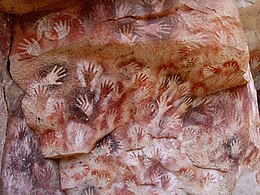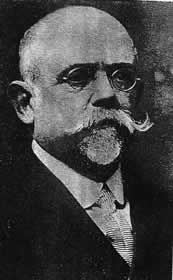|
Patagonia
   Patagonia adalah wilayah geografis yang terdiri dari bagian paling selatan Amerika Selatan. Patagonia terletak di Argentina dan Chili. Nama Patagonia berasal dari kata patagón[1] yang digunakan oleh Magellan untuk mendeskripsikan penduduk asli yang diduga oleh ekspedisinya sebagai raksasa. Kini dipercaya bahwa Patagon adalah suku Tehuelche dengan rata-rata tinggi 1.80 m (~5'11") dibandingkan dengan rata-rata tinggi orang Spanyol saat itu, 1.55 m (~5'1").[2] Di sebelah timur Andes, Patagonia terletak di sebelah selatan sungai Neuquén dan Colorado, dan di sebelah barat Andes, terletak di sebelah selatan 39°S, tidak termasuk Kepulauan Chiloé.[3] Di sebelah timur Andes, Patagonia yang terletak di Argentina meliputi provinsi Neuquén, Río Negro, Chubut, Santa Cruz, dan Tierra del Fuego, dan juga bagian selatan provinsi Buenos Aires, Mendoza dan La Pampa. Patagonia bagian Chili mencakup bagian selatan region Los Lagos, Aisén dan Magallanes. Patagonia tidak termasuk bagian Antartika yang diklaim oleh Chili dan Argentina. SejarahPatagonia Pra-Kolombus (10.000 SM-1520 AD)Tempat tinggal manusia di wilayah ini sudah ada sejak ribuan tahun lalu, dengan penemuan arkeologi yang berusia 13.000 SM, meskipun yang berusia sekitar 10.000 SM lebih dikenali. Terdapat bukti aktivitas manusia di Monte Verde, Provinsi Llanquihue, Chile, berusia sekitar 12.500 SM.[3] Lapangan es pada zaman es dan aliran air es yang mencair membuat sulit pemukiman pada saat itu. Wilayah ini terus dihuni sejak tahun 10.000 SM, dengan berbagai budaya dan gelombang migrasi, meskipun informasi selengkapnya kurang diketahui. Beberapa situs telah digali, gua penting seperti Cueva del Milodon[4] di Última Esperanza, Patagonia selatan, dan Tres Arroyos di Tierra del Fuego.[3] Tungku, pengikis batu, sisa binatang ditemukan di sebelah timur Andes dan berusia 9.400-9.200 SM.[3]  Cueva de las Manos adalah situs terkenal Santa Cruz, Argentina. Gua ini terletak di kaki bukit, memiliki lukisan dinding, terutama gambar ratusan tangan, yang dipercaya berusia 8.000 SM.[3] Perburuan guanako adalah aktivitas yang paling penting, dan rhea (ñandu) pada jangkauan yang lebih luas, dilihat dari artefak.[3] Tidak diketahui apakah megafauna Patagonia punah sebelum kedatangan manusia. Juga tidak jelas apakah anjing domestik merupakan bagian dari aktivitas manusia. Senjata bolas ditemukan dan digunakan untuk menangkap guanako dan rhea.[3] Tradisi maritim muncul pada suku Yámana di sebelah selatan Selat Beagle. Penduduk asli wilayah ini termasuk suku Tehuelche, yang jumlahnya berkurang hingga hampir punah tidak lama setelah kontak pertama dengan bangsa Eropa. Tehuelche meliputi Gununa'kena di utara, Mecharnuekenk di Patagonia selatan bagian tengah dan Aonikenk atau Tehuelche Selatan di selatan, sebelah utara selat Magelhaens. Di Isla Grande de Tierra del Fuego, Selk'nam (Ona) dan Haush (Mannekenk) tinggal di utara dan tenggara. Di kepulauan sebelah selatan Tierra del Fuego tinggal suku Yámana, dengan Kawéskar (Alakaluf) di daerah pantai dan kepulauan di sebelah barat Tierra del Fuego dan sebelah barat daya dari daratan.[3] Eksplorasi Eropa dan usaha penaklukan Spanyol (1520-1584)Wilayah Patagonia pertama kali dicatat oleh bangsa Eropa pada tahun 1520 oleh Fernando de Magelhaens, yang sedang dalam perjalanannya melewati pantai Teluk San Matias, Cape Virgenes, dan lainnya. Terdapat kemungkinan bahwa navigator seperti Amerigo Vespucci telah mencapai wilayah ini (catatannya pada tahun 1502 menyatakan mencapai garis lintang Patagonia), namun ia gagal mendeskripsikan kondisi geografis region Patagonia. Rodrigo de Isla, dikirim ke pedalaman Patagonia tahun 1535 dari San Matias oleh Simón de Alcazaba Sotomayor, dianggap sebagai orang Eropa pertama yang melintasi Patagonia raya. Jika bawahannya tidak memberontak, ia mungkin akan berhasil menyeberangi Andes untuk mencapai Chili. Pedro de Mendoza mendirikan Buenos Aires, tetapi tidak mengadakan eksplorasi ke selatan. Alonzo de Camargo (1539), Juan Ladrilleros (1557) dan Hurtado de Mendoza (1558) membantu mengenai pantai barat, dan perjalanan Sir Francis Drake tahun 1577 yang melewati pantai timur hingga mencapai selat dan bergerak ke utara menuju Chili dan Peru patut dikenang karena beberapa alasan; namun geografi Patagonia lebih berhutang kepada Pedro Sarmiento de Gamboa (1579–1580), yang mengabdikan dirinya untuk melakukan survey yang akurat. Permukiman yang ia dirikan di Nombre de Dios dan San Felipe dilalaikan oleh pemerintah Spanyol, dan ditinggalkan sebelum Thomas Cavendish mengunjunginya tahun 1587 dan sangat terpencil sehingga Thomas Cavendish menjulukinya "Pelabuhan Kelaparan" (Puerto Hambre). Distrik di sekitar Puerto Deseado, yang dieksplorasi oleh John Davis pada periode yang sama, dijadikan jajahan oleh Sir John Narborough atas nama Charles II dari Inggris tahun 1669. Patagonian giants: early European perceptionsAccording to Antonio Pigafetta,[1] one of the Magellan expedition's few survivors and its published chronicler, Magellan bestowed the name "Patagão" (or Patagón) on the inhabitants they encountered there, and the name "Patagonia" for the region. Although Pigafetta's account does not describe how this name came about, subsequent popular interpretations gave credence to a derivation meaning 'land of the big feet'. However, this etymology is questionable. The term is most likely derived from an actual character name, "Patagón", a savage creature confronted by Primaleón of Greece, the hero in the homonymous Spanish chivalry novel (or knight-errantry tale) by Francisco Vázquez.[5] This book, published in 1512, was the sequel of the romance "Palmerín de Oliva," much in fashion at the time, and a favourite reading of Magellan.[6] Magellan's perception of the natives, dressed in skins, and eating raw meat, clearly recalled the uncivilized Patagón in Vázquez's book.  The main interest in the region sparked by Pigafetta's account came from his reports of their meeting with the local inhabitants, who they claimed to measure some nine to twelve feet in height —"...so tall that we reached only to his waist"—, and hence the later idea that Patagonia meant "big feet". This supposed race of Patagonian giants or Patagones entered into the common European perception of this little-known and distant area, to be further fuelled by subsequent reports of other expeditions and famous-name travellers like Sir Francis Drake, which seemed to confirm these accounts. Early charts of the New World sometimes added the legend regio gigantum ("region of the giants") to the Patagonian area. By 1611 the Patagonian god Setebos (Settaboth in Pigafetta) was familiar to the hearers of The Tempest. The concept and general belief persisted for a further 250 years, and was to be sensationally re-ignited in 1767 when an "official" (but anonymous) account was published of Commodore John Byron's recent voyage of global circumnavigation in HMS Dolphin. Byron and crew had spent some time along the coast, and the publication (Voyage Round the World in His Majesty's Ship the Dolphin) seemed to give proof positive of their existence; the publication became an overnight best-seller, thousands of extra copies were to be sold to a willing public, and other prior accounts of the region were hastily re-published (even those in which giant-like folk were not mentioned at all). However, the Patagonian giant frenzy was to die down substantially only a few years later, when some more sober and analytical accounts were published. In 1773 John Hawkesworth published on behalf of the Admiralty a compendium of noted English southern-hemisphere explorers' journals, including that of James Cook and John Byron. In this publication, drawn from their official logs, it became clear that the people Byron's expedition had encountered were no taller than 6-foot 6 inches, tall perhaps but by no means giants. Interest soon subsided, although awareness of and belief in the myth persisted in some quarters even up into the 20th century.[7] Scientific exploration (1764-1842)In the second half of the 18th century, European knowledge of Patagonia was further augmented by the voyages of the previously-mentioned John Byron (1764–1765), Samuel Wallis (1766, in the same HMS Dolphin which Byron had earlier sailed in) and Louis Antoine de Bougainville (1766). Thomas Falkner, a Jesuit who resided near forty years in those parts, published his Description of Patagonia (Hereford, 1774); Francesco Viedma founded El Carmen, and Antonio advanced inland to the Andes (1782); and Basilio Villarino ascended the Rio Negro (1782). Two hydrographic surveys of the coasts were of first-rate importance: the first expedition (1826–1830) including HMS Adventure and HMS Beagle under Phillip Parker King, and the second (1832–1836) being the voyage of the Beagle under Robert FitzRoy. The latter expedition is particularly noted for the participation of Charles Darwin; however nothing was observed of the interior of the country except for 200 miles (320 km) of the course of the Santa Cruz river. Chilean and Argentine expansion (1843-1902) Following the last instructions of Bernardo O'Higgins, the Chilean president Manuel Bulnes sent an expedition to the Strait of Magellan and founded Fuerte Bulnes in 1843. Five years later, the Chilean government moved the main settlement to the current location of Punta Arenas, the oldest permanent settlement in Southern Patagonia. The creation of Punta Arenas was instrumental in making Chile's claim of the Strait of Magellan permanent. In the mid-19th century the newly-independent nations of Argentina and Chile began an aggressive phase of expansion into the south, increasing confrontation with the indigenous populations. In 1860, a French adventurer Orelie-Antoine de Tounens proclaimed himself king of The Kingdom of Araucania and Patagonia of the Mapuche. Captain George Chaworth Musters in 1869 wandered in company with a band of Tehuelches through the whole length of the country from the strait to the Manzaneros in the north-west, and collected a great deal of information about the people and their mode of life. In the 1870s the Conquest of the Desert was a controversial campaign by the Argentine government, executed mainly by General Julio Argentino Roca, to subdue or, some claim, to exterminate the native peoples of the South. By the mid-1880s the campaign's objectives had largely been achieved. In 1885 a mining expeditionary party under the Romanian adventurer Julius Popper landed in southern Patagonia in search of gold, which they found after travelling southwards towards the lands of Tierra del Fuego. This further opened up some of the area to prospectors.  European missionaries and settlers arrived through the 19th and 20th centuries, notably the Welsh settlement of the Chubut Valley. During the first years of the 20th century, the border between the two nations in Patagonia was established by the mediation of the British crown. But it has undergone a lot of modifications since then, and there is still one place (50 km long) where there is no border established (Southern Patagonia Icefield). Until 1902 most of Patagonia was settled by Chilotes who worked in cattle farming. Before and after 1902, when the boundaries were drawn, a lot of Chilotes were expelled from the Argentine side. These workers founded the first inland Chilean settlement in what is now the Aisén Region;[8][9] Balmaceda. Lacking good grasslands on the forest-covered Chilean side, the immigrants burned down the forest, setting fires that could have lasted more than two years.[9] Populasi
Catatan kaki
Pranala luarWikimedia Commons memiliki media mengenai Patagonia.
|


